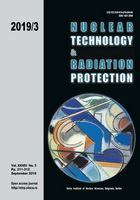
RADIONUCLIDES AND HEAVY METALS IN SOIL, VEGETABLES, AND MEDICINAL PLANTS IN SUBURBAN AREAS OF THE CITIES OF BELGRADE AND PANČEVO, SERBIA

Vol.
XXXIV, No. 3, Pp. 211-312
September 2019
UDC 621.039+614.876:504.06
ISSN 1451-3994
Pages: 278-284
Authors: Branislava M. Mitrović, Borjana R. Vranješ, Olga A. Kostić, Veljko S. Perović, Miroslava M. Mitrović, and Pavle Ž. PavlovićAbstract
The content of radionuclides (40K, 238U, 226Ra, 232Th, and 137Cs) and heavy metals (As, Cd, Cu, and Pb) was determined in samples of soil, vegetables and medicinal plants collected in the period 2007-2017, from two suburban areas of Belgrade – the municipalities of Palilula and Surčin, and Pančevo – the 'Dr Josif Pančić' Institute for the Study of Medicinal Herbs. During the research period, activity concentration of 137Cs in soil decreased from 16 Bqkg-1 to 3.9 Bqkg-1 (Palilula, Belgrade) and from 18 Bqkg-1 to 12 Bqkg-1 (Surčin, Belgrade). Mean activity concentrations of natural radionuclides in the soil were higher than the global average. Trend for heavy metal levels, according to the average concentrations found in the soil, were as follows: Cu >Pb >As >Cd for Palilula, Pb >Cu >As >Cd for Surčin and Dr Josif Pančić' Institute, Pančevo. The obtained results indicate that the industrial pollution has no impact on food production in the study area and that the main anthropogenic source of radionuclides and heavy metals in soil are mineral phosphorous fertilizers, often used in agricultural fields.
Key words: radionuclide, heavy metal, pollution, agricultural
FULL PAPER IN PDF FORMAT (568 KB)